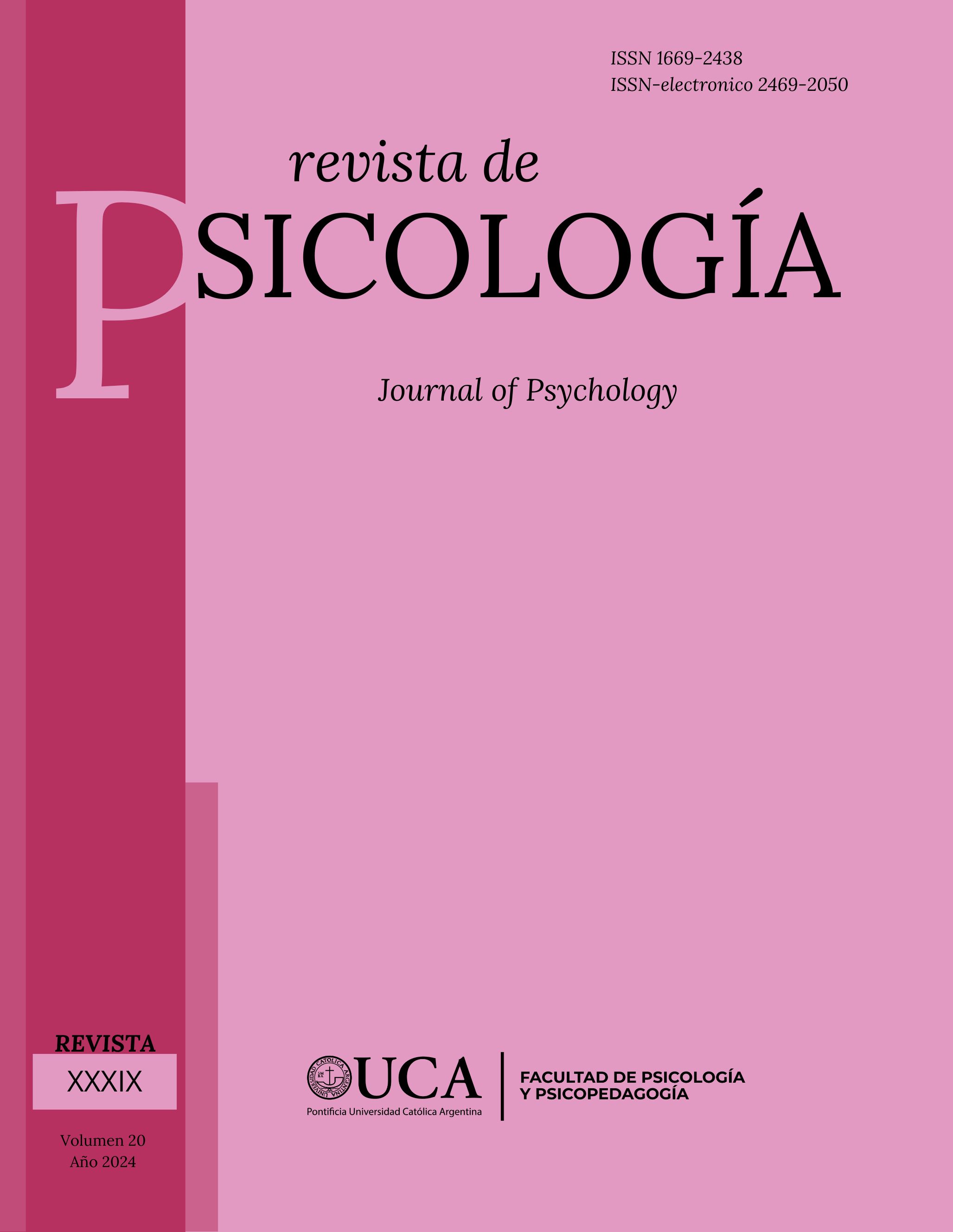Desafíos de la Comprensión Lectora Frente al Hipertexto en Adultos: Una Revisión Bibliográfica
DOI:
https://doi.org/10.46553/RPSI.20.39.2024.p29-43Palabras clave:
Hipertexto, Comprensión lectora, adultosResumen
El objetivo del artículo es discutir las contribuciones más relevantes de la última década en relación a la comprensión lectora en formato hipertexto, en población adulta sin dificultades de lectura y en su idioma materno. Algunos estudios plantean efectos negativos de la lectura en condiciones de hipertexto sobre la comprensión lectora. Otros estudios señalan la importancia de diferencias individuales cognitivas como variables moderadoras y mediadoras en estos efectos, entre ellas, el nivel de memoria de trabajo y el conocimiento previo del lector. Por otro lado, algunos estudios indican posibles variables externas moderadoras como el uso de soportes de navegación (uso de hipervínculos e instrucciones para facilitar la tarea de lectura y subrayados).
Descargas
Citas
Aichele, T. & Bannert, M. (2019). Comparing the Effects of Marginalia and Topic Sentences in Educational Hypertext. Journal of Educational Multimedia and Hypermedia, 28(2), 117-138.
Baddeley, A. D. (1986). Working memory. New York, NY: Clarendon Press/Oxford University Press.
Baddeley, A. D. (2000). The episodic buffer: A new component of working memory. Trends in Cognitive Sciences, 11(4), 417–423. https://doi.org/10.1016/s1364-6613(00)01538-2
Baddeley, A. D. (2003). Working memory and language: An overview. Journal of Communication Disorders, 36(3), 189–208. https://doi.org/10.1016/s0021-9924(03)00019-4
Bayazit, A., Bayram, S., & Kisilkaya Cumaoğlu, G. (2018). Investigating the relationship between task complexity, cognitive ability and disorientation in hypertext navigation. Cypriot Journal of Educational Sciences, 13(4), 431-443. https://doi.org/10.18844/wjet.v10i4.4088
Berger, S. (2001). Breaking Up News--an Investment in the Online Newspaper's Future?: Effects of Linear and Nonlinear Hypertext Formats on Users' Recall, Reading, Satisfaction, and Perceived Story Credibility [Doctoral dissertation]. State University System of Florida.
Bernacki, M. L., Byrnes, J. P., & Cromley, J. G. (2012). The effects of achievement goals and self-regulated learning behaviors on reading comprehension in technology-enhanced learning environments. Contemporary Educational Psychology, 37(2), 148-161. https://doi.org/10.1016/j.cedpsych.2011.12.001
Bezdan, E., Kester, L., & Kirschner, P. A. (2013). The influence of node sequence and extraneous load induced by graphical overviews on hypertext learning. Computers in Human Behavior, 29(3), 870–880. https://doi.org/10.1016/j.chb.2012.12.016
Boekaerts, M. (2011). Emotions, emotion regulation, and self-regulation of learning. En B. J. Zimmerman & D.H. Schunk (Eds.), Handbook of Self-Regulation of Learning and Performance, New York, NY: Routledge, 408–425.
Boekaerts, M., Zeidner, M., & Pintrich, P. R. (Eds.). (2000). Handbook of self-regulation. Elsevier. Academic Press, San Diego, CA US.
Bolter, J. D. (1993) Hypertext: The Convergence of Contemporary Critical Theory and Technology. The John Hopkins University Press
Bråten, I., Braasch, J. L., & Salmerón, L. (2020). Reading multiple and non-traditional texts: New opportunities and new challenges. Handbook of Reading Research, Volume V, 79-98.
Burger, J. M. & Cooper, H. M. (1979). The desirability of control. Motivation and Emotion, 3(4), 381–393. https://doi.org/10.1007/ BF00994052
Burin, D. I., Barreyro, J. P., Saux, G., & Irrazábal, N. (2015). Navegación y comprensión de textos digitales: estructuras de hipertexto, conocimientos previos del dominio y capacidad de memoria de trabajo. Electronic Journal of Research in Educational Psychology, 13(37), 529-550. https://doi.org/10.14204/ejrep.37.14136
Burin, D. I., Irrazabal, N., Injoque-Ricle, I., Saux, G., & Barreyro, J. P. (2018) Self-reported internet skills, previous knowledge and working memory in text comprehension in E-learning. International Journal of Education Technology in Higher Education, 15(18). https://doi.org/10.1186/s41239-018-0099-9
Burin, D. I., González, F. M., Barreyro, J. P., & Injoque-Ricle, I. (2020). Metacognitive regulation contributes to digital text comprehension in E-learning (2020). Metacognition and Learning, 15, 391–410. https://doi.org/10.1007/s11409-020-09226-8
Burin, D. I., González, F. M., Martínez, M., & Marrujo, J. G. (2021). Expository multimedia comprehension in E-learning: Presentation format, verbal ability and working memory capacity. Journal of Computer Assisted Learning, 37, 797–809. https://doi.org/10.1111/jcal.12524
Burin, D., Kahan, E., Irrazabal, N., & Saux, G. (2021). Procesos cognitivos en la comprensión de hipertexto: Papel de la estructura del hipertexto, de la memoria de trabajo, y del conocimiento previo. Ponencia presentada en el Congreso Iberoamericano de Educación Metas.
Cassany, D. (2000). De lo analógico a lo digital. El futuro de la enseñanza de la composición. Lectura y vida. Revista Latinoamericana de Lectura, 21(4), 6–15.
Clinton, V. (2019). Reading from paper compared to screens: A systematic review and meta-analysis. Journal of Research in Reading, 42(2), 288-325. https://doi.org/10.1111/1467-9817.12269
Conklin, J. (1987). Hypertext: An introduction and survey. IEEE Computer, 20, 17–41. https://doi.org/10.1109/MC.1987.1663693
Cordón García, J. A. & Jarvio Fernández, A. O. (2015). ¿Se está transformando la lectura y la escritura en la era digital? (Spanish). Revista Interamericana De Bibliotecología, 38(2), 137-145. https://doi.org/10.17533/udea.rib.v38n2a05
Delgado, P., Stang Lund, E., Salmerón, L., & Bråten, I. (2020). To click or not to click: Investigating conflict detection and sourcing in a multiple document hypertext environment. Reading and Writing, 33(8), 2049-2072.
Delgado, P., Vargas, C., Ackerman, R., & Salmerón, L. (2018). Don't throw away your printed books: A meta-analysis on the effects of reading media on reading comprehension. Educational Research Review, 25, 23-38. https://doi.org/10.1016/j.edurev.2018.09.003
Edwards, M. (2021). Learning from hypertext: navigation, comprehension, and working memory in university students [Doctoral dissertation]. Queen's University Belfast).
Fitzsimmons, G., Jayes, L. T., Weal, M. J., & Drieghe, D. (2020). The impact of skim reading and navigation when reading hyperlinks on the web. PloS one, 15(9), e0239134. https://doi.org/10.1371/journal.pone.0239134
Freund, L., Kopak, R., & O’Brien, H. (2016). The effects of textual environment on reading comprehension: Implications for searching as learning. Journal of Information Science, 42(1), 79-93. https://doi.org/10.1177/0165551515614472
Gagl, B. (2016). Blue hypertext is a good design decision: no perceptual disadvantage in reading and successful highlighting of relevant information. PeerJ, 4, e2467.
García Madruga, J.A. (2006). Lectura y conocimiento. Barcelona: Paidós.
Gottschling, S., Kammerer, Y., & Gerjets, P. (2019). Readers’ processing and use of source information as a function of its usefulness to explain conflicting scientific claims. Discourse Processes, 56(5-6), 429-446. https://doi.org/10.1080/0163853X.2019.1610305
Herrada-Valverde, G., & Herrada-Valverde, R. I. (2017). Factores que influyen en la comprensión lectora de hipertexto. Ocnos. Revista De Estudios Sobre Lectura, 16(2), 7–16. https://doi.org/10.18239/ocnos_2017.16.2.1287
Jáñez, A., Rosales, J., & Rouet, J. F. (2021). Effects of Hypertext Structure, navigation support and academic exposure to contents on learning from hypertext. Journal of Educational Multimedia and Hypermedia, 30(3), 257-282.
Jáñez, Á. & Rosales, J. (2020). Novices’ performance using hypertext materials: Shedding light on disorientation. Australasian Journal of Educational Technology, 36(4), 189-205. doi: 10.14742/ajet.4617
Jonassen, D. H. (1986). Hypertext principles for text and courseware design. Educational psychologist, 21(4), 269-292. https://doi.org/10.1207/s15326985ep2104_3
Jung, W., Olfman, L., Ryan, T., & Park, Y.-T. (2005). An experimental study of the effects of contextual data quality and task complexity on decision performance. Paper presented at the Information Reuse and Integration, Conf, 2005. IRI-2005 IEEE International Conference on. https://doi.org/10.1109/IRI-05.2005.1506465
Kintsch, W. (1998). Comprehension: a paradigm for cognition. New York: Cambridge University Press.
Kintsch, W. & Kintsch, E. (2005). Comprehension. En S. G. Paris, & S. A. Stahl (Eds.) Children's reading comprehension and assessment. Routledge.
Lagerwerf, L. & Verheij, D. (2014). Hypertext in online news stories: More control, more appreciation. Information Design Journal, 21(2), 163-178. https://doi.org/10.1075/idj.21.2.07lag
Lazonder, A. W., Biemans, H. J. A., & Wopereis, I. G. J. H. (2000). Differences between novice and experienced users in searching information on the World Wide Web. Journal of the American society for Information science, 51(6), 576-581. https://doi.org/10.1002/(SICI)1097-4571(2000)51:6<576::AID-ASI9>3.0.CO;2-7
Li, L.-Y., Tseng, S.-T., & Chen, G.-D. (2016). Effect of hypertext highlighting on browsing, reading, and navigational performance. Computers in Human Behavior, 54, 318-325. https://doi.org/10.1016/j.chb.2015.08.012
Mangen, A., Walgermo, B. R., & Brønnick, K. (2013). Reading linear texts on paper Versus computer screen: Effects on reading comprehension. International Journal of Educational Research, 58, 61–68. https://doi.org/ 10.1016/j.ijer.2012.12.002
Nanda, D. S. & Susanto, S. (2020). The emergence of Cyber Literature: A challenge to teach literature from text to hypertext. https://doi.org/10.35542/osf.io/q8psj
National Assessment Governing Board. (2008). Reading Framework for the 2009 National Assessment of Educational Progress. Washington, DC: Author
Nielsen, J. (1999). When Bad Design Elements Become the Standard, Jakob Nielsen's Alertbox.
Page, M. J., Mckenzie, J. E., Bossuyt, P. M., Boutron, I., Hoffmann, T. C., Mulrow, C. D., Shamseer, L., Tetzlaff, J. M., Akl, E. A., Brennan, S. E., Chou, R., Glanville, J., Grimshaw, J. M., Hróbjartsson, A., Lalu, M. M., Li, T., Loder, E. W., Mayo-Wilson, E., Mcdonald, S., … Moher, D. (2021). The PRISMA 2020 statement: An updated guideline for reporting systematic reviews. Systematic Reviews, 10(89), 10-10. https://doi.org/10.1186/s13643-021-01626-4
Patterson, N. G. (2000). Hypertext and the changing roles of readers. The English Journal, 90(2), 74-80. https://doi.org/ 10.2307/821221
Romero, L. (2014). Lectura tradicional versus lectura digital. Correspondencias & Análisis, 4, 63-75. https://doi.org/10.24265/cian.2014.n4.03
Romero-Otero, I., Iglesias-Fernández, E., & Giménez-Toledo, E. (2013). Use, acceptance and expectations for the ebook in a research library. Bid, 31, 1-10. https://doi.org/10.1344/BiD2014.31.15
Rouet, J. F., Vörös, Z., & Pléh, C. (2012). Incidental learning of links during navigation: The role of visuo-spatial capacity. Behaviour & Information Technology, 31(1), 71-81. https://doi.org/10.1080/0144929X.2011.604103
Salmerón, L., Canas, J. J., Kintsch, W., & Fajardo, I. (2005). Reading strategies and hypertext comprehension. Discourse processes, 40(3), 171-191. https://doi.org/10.1207/s15326950dp4003_1
Salmerón, L., & García, V. (2011). Reading skills and children’s navigation strategies in hypertext. Computers in Human Behavior, 27(3), 1143-1151. https://doi.org/10.1016/j.chb.2010.12.008
Salmerón, L., Strømsø, H. I., Kammerer, Y., Stadtler, M., & Van den Broek, P. (2018). Comprehension processes in digital reading. En M. Barzillai, J. Thomson, S. Schroeder, & P. Van den Broek (Eds.), Learning to read in a digital world, 91-120.
Schurer, T., Opitz, B., & Schubert, T. (2020). Working memory capacity but not prior knowledge impact on readers' attention and text comprehension. Frontiers in Education, 5, 26. https://doi.org/10.3389/feduc.2020.00026
Schunk, D. H. & Zimmerman, B. J. (Eds.). (2008). Motivation and self-regulated learning: Theory, research, and applications. Routledge.
Singer, L. M. & Alexander, P. A. (2017). Reading on paper and digitally: What the past decades of empirical research reveal. Review of educational research, 87(6), 1007-1041.
Soria Andurell, A. (2015). Hipertexto y comprensión lectora. Investigaciones sobre lectura, 4. RIUMA (Repositorio Institucional de la Universidad de Málaga). Recuperado de: https://riuma.uma.es/xmlui/handle/10630/10938
Smith, J. B. & Weiss, S. F. (Eds.). (1988). Hypertext. Communications of the ACM, 31(7), 816-819.
Urakami, J. & Krems, J. F. (2012). How hypertext reading sequences affect understanding of causal and temporal relations in story comprehension. Instructional Science, 40(2), 277-295. https://doi.org/10.1007/s11251-011-9178-1
Wästlund, E., Reinikka, H., Norlander, T., & Archer, T. (2005). Effects of VDT and paper presentation on consumption and production of information: Psychological and physiological factors. Computers in Human Behavior, 21(2), 377–394. https://doi.org/10.1016/j.chb.2004.02.007
Waniek, J. (2012). How information organisation affects users' representation of hypertext structure and content. Behaviour & Information Technology, 31(2), 143-154. https://doi.org/10.1080/01449290903544652
Wardrip-Fruin, N. (2004). What hypertext is. In Proceedings of the fifteenth ACM conference on Hypertext and hypermedia (126-127).
Zimmerman, B. J. & Schunk, D. H. (Eds.). (2011). Handbook of self-regulation of learning and performance. New York, NY: Routledge
Publicado
Cómo citar
Número
Sección
Licencia
Derechos de autor 2024 Ana Alejandra Fuentes Cuiñas

Esta obra está bajo una licencia internacional Creative Commons Atribución-NoComercial-CompartirIgual 4.0.



















